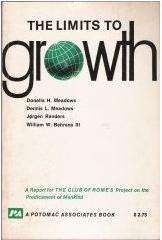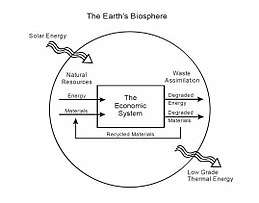The Limits to Growth
 The Limits to Growth first edition cover. | |
| Authors | |
|---|---|
| Language | English |
| Published | 1972 |
| Publisher | Potomac Associates - Universe Books |
| Pages | 205 |
| ISBN | 0-87663-165-0 |
| OCLC | 307838 |
| digital: Digitized 1972 edition | |
| Part of a series on |
| Ecological economics |
|---|
 Man's economic system viewed as a subsystem of the global environment |
|
Concepts
|

The Limits to Growth (LTG) is a 1972 report[1] on the computer simulation of exponential economic and population growth with a finite supply of resources.[2] Funded by the Volkswagen Foundation[3] and commissioned by the Club of Rome, the findings of the study were first presented at international gatherings in Moscow and Rio de Janeiro in the summer of 1971.[1]:186 The report's authors are Donella H. Meadows, Dennis L. Meadows, Jørgen Randers, and William W. Behrens III, representing a team of 17 researchers.[1]:8
Since its publication, some 30 million copies of the book in 30 languages have been purchased.[4] It continues to generate debate and has been the subject of several subsequent publications.[5] Most recently, The Limits to Growth: The 30-Year Update was published on June 1, 2004.[6]
Purpose
In commissioning the MIT team to undertake the project that resulted in LTG, the Club of Rome had two objectives:[1]:185
- Gain insights into the limits of our world system and the constraints it puts on human numbers and activity.
- Identify and study the dominant elements, and their interactions, that influence the long-term behavior of world systems.
Methodology
The study used the World3 computer model to simulate the consequence of interactions between the earth and human systems.[7][8] The model was based on the work of Jay Forrester of MIT,[1]:21 as described in his book World Dynamics.[9]
The model was based on five variables: "population, food production, industrialization, pollution, and consumption of nonrenewable natural resources".[1]:25 At the time of the study, all these variables were increasing and were assumed to continue to grow exponentially, while the ability of technology to increase resources grew only linearly.[1] The authors intended to explore the possibility of a sustainable feedback pattern that would be achieved by altering growth trends among the five variables under three scenarios. They noted that their projections for the values of the variables in each scenario were predictions "only in the most limited sense of the word", and were only indications of the system's behavioral tendencies.[10] Two of the scenarios saw "overshoot and collapse" of the global system by the mid- to latter-part of the 21st century, while a third scenario resulted in a "stabilized world".[11]:11
Exponential reserve index

A key idea in The Limits to Growth is the notion that if the rate of resource use is increasing, the amount of reserves cannot be calculated by simply taking the current known reserves and dividing by the current yearly usage, as is typically done to obtain a static index. For example, in 1972, the amount of chromium reserves was 775 million metric tons, of which 1.85 million metric tons were mined annually. The static index is 775/1.85=418 years, but the rate of chromium consumption was growing at 2.6 percent annually, or exponentially.[1]:54–71 If instead of assuming a constant rate of usage, the assumption of a constant rate of growth of 2.6 percent annually is made, the resource will instead last
In general, the formula for calculating the amount of time left for a resource with constant consumption growth is:[12]
where:
- y = years left;
- r = 0.026, the continuous compounding growth rate (2.6%).
- s = R/C or static reserve.
- R = reserve;
- C = (annual) consumption.
The authors list a number of similar exponential indices comparing current reserves to current reserves multiplied by a factor of five:
Years Resource Consumption, annual growth rate Static index Exponential index 5x reserves exponential index Chromium 2.6% 420 95 154 Gold 4.1% 11 9 29 Iron 1.8% 240 93 173 Petroleum 3.9% 31 20 50
The static reserve numbers assume that the usage is constant, and the exponential reserve assumes that the growth rate is constant.
The exponential index has been interpreted as a prediction of the number of years until the world would "run out" of various resources, both by environmentalist groups calling for greater conservation and restrictions on use, and by skeptics criticizing the index when supplies failed to run out.[13][14][15][16] What The Limits to Growth actually has is the above table, which has the current reserves (that is no new sources of oil are found) for oil running out in 1992 assuming constant exponential growth. In Limits to Growth: The Thirty Year Update there are several pages explaining that new resources are found over time and that the current reserves therefore change but that ultimately resources are finite. (Earlier editions did explain this as well, but not in as much detail.) The standard model includes a resource base of double that of what they have calculated, but the book includes model runs where the assumed resources are infinite, but those model runs still result in overshoot and collapse from other factors.
Conclusions
After reviewing their computer simulations, the research team came to the following conclusions:[1]:23–24
- Given business as usual, i.e., no changes to historical growth trends, the limits to growth on earth would become evident by 2072, leading to "sudden and uncontrollable decline in both population and industrial capacity".
- Growth trends existing in 1972 could be altered so that sustainable ecological and economic stability could be achieved.
- The sooner the world's people start striving for the second outcome above, the better the chance of achieving it.
Criticism
Criticism of LTG was immediate. Peter Passell and two co-authors published a 2 April 1972 article in the New York Times describing LTG as "...an empty and misleading work .... best summarized ... as a rediscovery of the oldest maxim of computer science: Garbage In, Garbage Out." Passell found the study's simulations to be simplistic, while assigning little value to the role of technological progress in solving the problems of resource depletion, pollution, and food production. They charged that all LTG simulations ended in collapse, predicted the imminent end of irreplaceable resources, and, finally, that the entire endeavor was motivated by a hidden agenda: to halt growth in its tracks.[17]
In 1973, a group of researchers at the Science Policy Research Unit at the University of Sussex, published Models of Doom; A Critique of The Limits to Growth. The Sussex group examined the structure and assumptions of the MIT models. They concluded that the simulations were very sensitive to a few key assumptions and suggest that the MIT assumptions were unduly pessimistic. The Sussex scientists concluded that the MIT methodology, data, and projections were faulty and do not accurately reflect reality.[18] Claiming that the Sussex critics applied "micro reasoning to macro problems", the LTG team, in "A Response to Sussex", described and analyzed five major areas of disagreement between themselves and the Sussex authors.[19]
The report has been criticized by academics, economists and businessmen.[20][21] Critics claimed that history proved the projections to be incorrect, which was specifically based on the popular belief that The Limits to Growth predicted resource depletion and associated economic collapse by the end of the 20th century.[22]:23 The Limits to Growth faced ridicule as early as the 1970s.[23][24] Attacks were made on the methodology, the computer, the conclusions, the rhetoric and the people behind the project.[25] Yale economist Henry C. Wallich agreed that growth could not continue indefinitely, but that a natural end to growth was preferable to intervention. Wallich stated that technology could solve all the problems the report was concerned about, but only if growth continued apace. By stopping growth too soon, Wallich warned, the world would be "consigning billions to permanent poverty".[25]
Julian Simon, a professor at the Universities of Illinois and, later, Maryland, argued that the fundamental underlying concepts of the LTG scenarios were faulty, because the very idea of what constitutes a "resource" varies over time. For instance, wood was the primary shipbuilding resource until the 1800s, and there were concerns about prospective wood shortages from the 1500s on. But then boats began to be made of iron, later steel, and the shortage issue disappeared. Simon argued in his book The Ultimate Resource that human ingenuity creates new resources as required from the raw materials of the universe. For instance, copper will never "run out". History demonstrates that as it becomes scarcer its price will rise and more will be found, more will be recycled, new techniques will use less of it, and at some point a better substitute will be found for it altogether.[26] His book was revised and reissued in 1996 as The Ultimate Resource 2.[27]
Robert Solow from MIT argued that prediction in The Limits to Growth was based on a weak foundation of data. Allen Kneese and Ronald Riker of Resources for the Future (RFF) stated, "The authors load their case by letting some things grow exponentially and others not. Population, capital and pollution grow exponentially in all models, but technologies for expanding resources and controlling pollution are permitted to grow, if at all, only in discrete increments."
Critics also argue that the authors of the report claimed to accept that the then-known resources of minerals and energy could, and would, grow in the future, and consumption growth rates could also decline. The theoretical expiry time for each resource would therefore need to be updated as new discoveries, technologies and trends came to light. Writing in Forbes, one critic pointed out that "...while we do indeed face hard limits to the availability of metals and or minerals these hard limits are so far away that they're not...something we should worry about..." and that "...everything is substitutable. Absolutely everything is, no exceptions." Thus substituting metals and minerals for fossil fuels is the very basis of renewable energy.[28]
By "...the 1990s LTG had become everyone's laughing stock....In short, Chicken Little with a computer."[29] In 1997, the Italian economist Giorgio Nebbia, observed that the negative reaction to the LTG study came from at least four sources: those who saw the book as a threat to their business or industry; professional economists, who saw LTG as an uncredentialed encroachment on their professional perquisites; the Catholic church, which bridled at the suggestion that overpopulation was one of mankind's major problems; finally, the political left, which saw the LTG study as a scam by the elites designed to trick workers into believing that a proletarian paradise was a pipe dream.[29]
Positive reviews
In the early years of the 21st century, the tide of opinion regarding LTG began to swing in a positive direction.[29] Reading LTG for the first time in 2000, influential energy economist Matthew Simmons concluded his views on the report by saying, "In hindsight, The Club of Rome turned out to be right. We simply wasted 30 important years ignoring this work."[30]
In 2008, Graham Turner of the Commonwealth Scientific and Industrial Research Organisation (CSIRO) found that the observed historical data from 1970 to 2000 closely match the simulated results of the "standard run" limits of growth model for almost all the outputs reported. "The comparison is well within uncertainty bounds of nearly all the data in terms of both magnitude and the trends over time." Turner also examined a number of reports, particularly by economists, which over the years have purported to discredit the limits-to-growth model. Turner says these reports are flawed, and reflect misunderstandings about the model.[11]:37
In 2010, Nørgård, Peet and Ragnarsdóttir called the book a "pioneering report", and said that it "has withstood the test of time and, indeed, has only become more relevant."[4]
In 2014, The Guardian published an article showing that data collected since LTG's publication in 1972 supports the accuracy of the 1972 projections.[31]
Christian Parenti, writing in 2012, sees parallels between the reception of LTG and the contemporary climate debate, "That said, The Limits to Growth was a scientifically rigorous and credible warning that was actively rejected by the intellectual watchdogs of powerful economic interests. A similar story is playing out now around climate science."[32]
Legacy
The Club of Rome has persisted after The Limits of Growth and has generally provided comprehensive updates to the book every five years.
An independent retrospective on the public debate over The Limits to Growth concluded in 1978 that optimistic attitudes had won out, causing a general loss of momentum in the environmental movement. While summarizing a large number of opposing arguments, the article concluded that "scientific arguments for and against each position ... have, it would seem, played only a small part in the general acceptance of alternative perspectives."[33]
In 1989, a symposium was held in Hanover, Lower Saxony, entitled "Beyond the Limits to Growth: Global Industrial Society, Vision or Nightmare?" In 1993, Beyond the Limits was published as a 20-year update on the original material. Limits to Growth: The 30-Year Update was published in 2004.
In 2008, Graham Turner at the Commonwealth Scientific and Industrial Research Organisation (CSIRO) in Australia published a paper called "A Comparison of 'The Limits to Growth' with Thirty Years of Reality".[11] It compared the past thirty years of data with the scenarios laid out in the 1972 book and found that changes in industrial production, food production, and pollution are all congruent with one of the book's three scenarios—that of "business as usual". This scenario in Limits points to economic and societal collapse in the 21st century.[34] In 2010, Nørgård, Peet, and Ragnarsdóttir called the book a "pioneering report". They said that, "its approach remains useful and that its conclusions are still surprisingly valid ... unfortunately the report has been largely dismissed by critics as a doomsday prophecy that has not held up to scrutiny."[4]
Also in 2008, researcher Peter A. Victor wrote, that even though the Limits team probably underestimated price mechanism's role in adjusting outcomes, their critics have overestimated it. He states that Limits to Growth has had a significant impact on the conception of environmental issues and notes that the models in the book were meant to be taken as predictions "only in the most limited sense of the word".[10]
In a 2009 article published in American Scientist titled "Revisiting the Limits to Growth After Peak Oil", Hall and Day noted that "the values predicted by the limits-to-growth model and actual data for 2008 are very close."[35] These findings are consistent with the 2008 CSIRO study which concluded: "The analysis shows that 30 years of historical data compares favorably with key features ... [of the Limits to Growth] "standard run" scenario, which results in collapse of the global system midway through the 21st Century."[11]
In 2011, Ugo Bardi published a book-length academic study of The Limits to Growth, its methods and historical reception and concluded that "The warnings that we received in 1972 ... are becoming increasingly more worrisome as reality seems to be following closely the curves that the ... scenario had generated."[36]:3 A popular analysis of the accuracy of the report by science writer Richard Heinberg was also published.[37]
In 2012, the Smithsonian Institution held a symposium entitled "Perspectives on Limits to Growth".[38] Another symposium was held in Hanover, Germany entitled "Already Beyond?"[39]
Limits to Growth did not receive an official update in 2012, but one of its coauthors, Jørgen Randers, published a book, 2052: A Global Forecast for the Next Forty Years.[40][41]
In 2012, writing in American Scientist, Brian Hayes stated that the model is "more a polemical tool than a scientific instrument". He went on to say that the graphs generated by the computer program should not, as the authors note, be used as predictions.[42]
In 2014, Graham Turner concluded that "preparing for a collapsing global system could be even more important than trying to avoid collapse."[43]
In 2016, a report published by the UK All-Party Parliamentary Group on Limits to Growth concluded that "there is unsettling evidence that society is still following the 'standard run' of the original study – in which overshoot leads to an eventual collapse of production and living standards".[44] The report also points out that some issues not fully addressed in the original 1972 report, such as climate change, present additional challenges for human development.
Related books
Many books about humanity's uncertain future have appeared regularly over the years. Precursors to Limits to Growth included Thomas Malthus's An Essay on the Principle of Population (1798), Harrison Brown's The Challenge of Man's Future (1956), Rachel Carson's Silent Spring (1962) and Paul R. Ehrlich's The Population Bomb (1968).[45] Some of the notable books published after 1972 include the State of the World reports issued by the Worldwatch Institute (produced annually since 1984); the influential Our Common Future, published by the UN’s World Commission on Environment and Development (1987); Earth in the Balance, written by then-US senator Al Gore (1992); and Earth Odyssey by journalist Mark Hertsgaard (1999).[45]
Editions
- ISBN 0-87663-165-0, 1972 first edition (digital version)
- ISBN 0-87663-222-3, 1974 second edition (cloth)
- ISBN 0-87663-918-X, 1974 second edition (paperback)
- Meadows, Donella; Randers, Jorgen; Meadows, Dennis (June 2004). Limits To Growth: The 30-Year Update (Paperback ed.). Chelsea Green Publishing. ISBN 193149858X. Retrieved 1 December 2017.
- Meadows, Donella; Randers, Jorgen; Meadows, Dennis (March 2005). Limits To Growth: The 30-Year Update (Hardcover ed.). Chelsea Green Publishing. ISBN 1931498512. Retrieved 1 December 2017.
See also
- Attractiveness principle
- Albert Allen Bartlett
- Cornucopian
- Donella Meadows' twelve leverage points to intervene in a system
- DYNAMO (programming language)
- Degrowth
- Ecological economics
- Economic growth
- Energy crisis
- Energy development
- Garbage in, garbage out
- Genetic bottleneck
- Hubbert peak theory
- Jevons's paradox
- List of environmental books
- Malthusian catastrophe
- Negative Population Growth
- Olduvai theory
- Overpopulation
- Peak oil
- Planetary boundaries
- Population Connection (formerly 'Zero Population Growth')
- Post-growth
- Productivism
- Richard Rainwater
- Julian L. Simon
- Societal collapse
- Steady-state economy
- System dynamics
- The Global 2000 Report to the President
- The Coal Question
- The Population Bomb
- The Revenge of Gaia
References
- 1 2 3 4 5 6 7 8 9 Meadows, Donella H; Meadows, Dennis L; Randers, Jørgen; Behrens III, William W (1972). The Limits to Growth; A Report for the Club of Rome's Project on the Predicament of Mankind (PDF). New York: Universe Books. ISBN 0876631650. Retrieved 26 November 2017.
- ↑ MacKenzie, Debora (4 January 2012). "Boom and doom: Revisiting prophecies of collapse". New Scientist. Retrieved 2017-11-28.
- ↑ "Symposium: Already Beyond? - 40 Years Limits to Growth". Volkswagen Stiftung. 28 November 2012. Retrieved 2017-11-28.
- 1 2 3 Nørgård, Jørgen Stig; Peet, John; Ragnarsdóttir, Kristín Vala (March 2010). "The History of The Limits to Growth". The Solutions Journal. 1 (2): 59–63. Retrieved 1 July 2014.
- ↑ Farley, Joshua C. "The Limits to growth debate". The University of Vermont. Retrieved 1 December 2017.
- ↑ Meadows, Donella H.; Randers, Jorgen; Meadows, Dennis L. (2004). The Limits to Growth: The 30-Year Update. White River Junction VT: Chelsea Green Publishing Co. ISBN 1931498512. Retrieved 27 November 2017.
- ↑ The models were run on DYNAMO, a simulation programming language.
- ↑ Edwards, Paul N. (2010) A Vast Machine: Computer Models, Climate Data, and the Politics of Global Warming MIT Press ISBN 9780262290715 pp. 366–71
- ↑ Forrester, Jay Wright (1971). World Dynamics. Wright-Allen Press. ISBN 0262560186.
- 1 2 Peter A. Victor (2008). Managing Without Growth, Edward Elgar Publishing, pp. 92–93, ISBN 978-1-84720-078-5
- 1 2 3 4 Turner, Graham (2008). "A Comparison of 'The Limits to Growth' with Thirty Years of Reality". Socio-Economics and the Environment in Discussion (SEED). CSIRO Working Paper Series. Commonwealth Scientific and Industrial Research Organisation (CSIRO). 2008-09: 52. doi:10.1016/j.gloenvcha.2008.05.001. ISSN 1834-5638. Retrieved 1 July 2014.
- ↑ Limits To Growth, pg 60, Derivation: reverts to
- ↑ The Skeptical Environmentalist, p. 121
- ↑ Chapter 17: Growth and Productivity-The Long-Run Possibilities Archived 2010-12-18 at the Wayback Machine.
- ↑ "Treading lightly". The Economist. 19 September 2002. Archived from the original on 12 November 2007.
- ↑ Bailey, Ronald (4 February 2004). "Science and Public Policy". Reason. Retrieved 26 November 2017.
- ↑ Passell, Peter; Roberts, Marc; Ross, Leonard (1972-04-02). "The Limits to Growth". New York Times. Retrieved 2 December 2017.
- ↑ Cole, H. S. D.; Freeman, Christopher; Jahoda, Marie; Pavitt, K. L. R., eds. (1 April 1973). Models of Doom: A Critique of the Limits to Growth (1st, hardcover ed.). Universe Publishing. ISBN 0876631847. Retrieved 2 December 2017.
- ↑ Meadows, Donella H; Meadows, Dennis L; Randers, Jørgen; Behrens III, William W (February 1973). "A response to Sussex". Futures. 5 (1): 135–152. doi:10.1016/0016-3287(73)90062-1. Retrieved 2 December 2017.
- ↑ Meyer, N.I.; Nørgård, J.S. (2010). Policy Means for Sustainable Energy Scenarios (abstract) (PDF). Denmark: International Conference on Energy, Environment and Health – Optimisation of Future Energy Systems. pp. 133–137. Archived from the original (PDF) on 9 October 2016. Retrieved 27 November 2017.
- ↑ Cole, H S D (1973). Models of Doom: A Critique of The Limits to Growth. Universe Books. ISBN 0876639058. Retrieved 27 November 2017.
- ↑ van Vuuren, D. P.; Faber, A (2009). Growing within Limits – A Report to the Global Assembly 2009 of the Club of Rome (PDF). Bilthoven: Netherlands Environmental Assessment Agency. ISBN 9789069602349. Retrieved 27 November 2017.
- ↑ Kaysen, Carl (1972). "The Computer That Printed out W*O*L*F*". Foreign Affairs. 50 (4): 660–668. doi:10.2307/20037939. JSTOR 20037939.
- ↑ Solow, Robert M. (1973). "Is the End of the World at Hand?". Challenge. 16 (1): 39–50. doi:10.1080/05775132.1973.11469961. JSTOR 40719094.
- 1 2 Alan Atkisson (2010). Believing Cassandra: How to be an Optimist in a Pessimist's World, Earthscan, p. 13.
- ↑ Simon, Julian (August 1981). The Ultimate Resource (Hardcover ed.). Princeton: Princeton University Press. ISBN 069109389X. Retrieved 6 December 2017.
- ↑ Simon, Julian L (1996). The Ultimate Resource 2 (Paperback ed.). Princeton: Princeton University Press. ISBN 0691042691. Retrieved 6 December 2017.
- ↑ Worstall, Tim (2012-04-09). "The Club of Rome's Limits to Growth Updated: Entirely Bizarre". Forbes. Retrieved 30 November 2017.
- 1 2 3 Bardi, Ugo (9 March 2008). "Cassandra's Curse: how "The Limits to Growth" was demonized". The Oil Drum: Europe. Retrieved 1 December 2017.
- ↑ Simmons, Matthew R. (October 2000). "Revisiting The Limits to Growth: Could the Club of Rome Have Been Correct After All?" (PDF). Mud City Press. Retrieved 29 November 2017.
- ↑ Turner, Graham; Alexander, Cathy (2 September 2014). "Limits to Growth was right. New research shows we're nearing collapse". The Guardian. Retrieved 28 November 2017.
- ↑ Parenti, Christian (5 December 2012). "'The Limits to Growth': A Book That Launched a Movement". The Nation (24-31 December 2012 issue). Retrieved 30 November 2017.
- ↑ Sandbach, Francis (1 November 1978). "The Rise and Fall of the Limits to Growth Debate". Social Studies of Science. 8 (4): 495–520. doi:10.1177/030631277800800404.
- ↑ "Prophesy of economic collapse 'coming true'", by Jeff Hecht, New Scientist, 17 November 2008
- ↑ Hall, Charles A. S.; John W. Day (May–June 2009). "Revisiting the Limits to Growth After Peak Oil" (PDF). American Scientist. Sigma Xi, The Scientific Research Society/State University of New York College of Environmental Science and Forestry. 97: 230–237. doi:10.1511/2009.78.230. Retrieved 1 July 2014.
- ↑ Bardi, Ugo (2011). The Limits to Growth Revisited. New York: Springer. ISBN 9781441994158. Retrieved 27 November 2017.
- ↑ Heinberg, Richard (2011). The End of Growth: Adapting to Our New Economic Reality (3rd printing ed.). Gabriola Island, BC: New Society Publishers. ISBN 0865716951.
- ↑ "Perspectives on Limits to Growth: Challenges to Building a Sustainable Planet" (PDF). Smithsonian Institution. Smithsonian Institution—Club of Rome. 2012-03-01. Retrieved 28 November 2017.
- ↑ "Documentation: "Already Beyond? - 40 Years Limits to Growth"". Volkswagen Stiftung. Retrieved 28 November 2017.
- ↑ Randers, Jorgen (June 2012). 2052. A Global Forecast for the Next Forty Years. White River Junction, VT: Chelsea Green Publishing Co. ISBN 1603584218.
- ↑ "2052. A Global Forecast for the Next 40 Years". 2052. A Global Forecast for the Next 40 Years. Retrieved 28 November 2017.
- ↑ Brian Hayes (May–June 2012). "Computation and the Human Predicament – The Limits to Growth and the Limits to Computer Modeling". American Scientist. doi:10.1511/2012.96.186.
- ↑ Turner, Graham (August 2014). Rickards, Lauren, ed. "Is Global Collapse Imminent?" (PDF). sustainable.unimelb.edu.au (Research Paper No. 4). MSSI Research Papers. Melbourne, Australia: Melbourne Sustainable Society Institute, The University of Melbourne. p. 16. ISBN 978-0-7340-4940-7. Retrieved 2014-10-19.
Regrettably, the alignment of data trends with the LTG dynamics indicates that the early stages of collapse could occur within a decade, or might even be underway. This suggests, from a rational risk-based perspective, that we have squandered the past decades, and that preparing for a collapsing global system could be even more important than trying to avoid collapse.
- ↑ Jackon, Tim; Webster, Robin (April 2016). Limits Revisited: A Review of the Limits to Growth Debate (PDF) (Report). London: All-Party Parliamentary Group on Limits to Growth. Retrieved October 23, 2016.
- 1 2 Alan Atkisson (2010). "Believing Cassandra: How to be an Optimist in a Pessimist's World", Earthscan, pp. 17–18.
External links
| Wikimedia Commons has media related to The Limits to Growth. |
| Wikiversity has learning resources about Limits To Growth |
